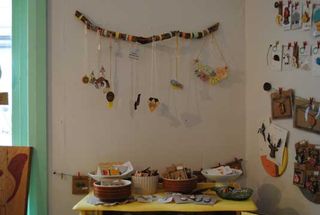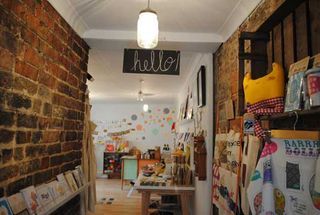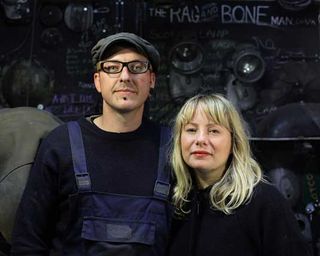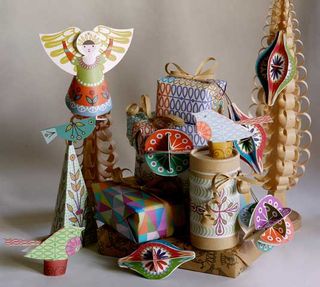Turn your design skills into a business: 10 pro tips
Want to put your design skills to good use and start your own company? Then follow this expert advice.
So you're an illustrator, a graphic designer, a photographer. But it's not enough. You want to take the next step and start a business. But before you drop everything and spend your precious pennies on a spanking new studio, specialist shop or ecommerce website, you should know a few things.
Creating great design is one thing, but being an entrepreneur and making a business out of it is quite another. Here's some advice from some of those who've taken the plunge and come out of the other side smiling...
01. There's no entry requirement

Good news - you don't have to have a business degree to start your own creative enterprise. There's no denying you've got to be a bit of a tough cookie to run your own show, but don't be put off by the accounts and business jargon.
Founder of By The Yard Bex Smith doesn't even have a qualification in art or design, but she's a firm believer in doing what you love. So she launched this bricks and mortar shop in Cheltenham about a year ago, where she sells a variety of beautiful arty items, including her own creations.
"Life is too short to waste your ambition with what-ifs," says the Norfolk-born lass. "This was my ultimate motivation in opening the shop. There's no point having dreams if you're not going to do anything towards achieving them. In some ways I have a business head, but in other ways I'm completely useless!"
02. Get some business skills
Although you don't need qualifications to start your own business, if you're not business minded, you'll soon be having problems. But there are loads of brilliant courses around to help you get your head around it all.
Visual artist Nancy Nicholson, who runs a commercial design business, found the School for Creative Startups incredibly useful. Fifty+ but still young at heart, Nicholson found the part-time course made her hungry to learn more about running a successful business. "It's precipitated me headlong into the exciting start of a proper little business, and has been hugely supportive during that process," she says.
Get the Creative Bloq Newsletter
Daily design news, reviews, how-tos and more, as picked by the editors.
03. Be creative with display

Taking a bit of time to think about how you display your goods can really save you a lot of money. To help hers stand out, Smith has come up with some pretty creative display solutions.
From potato crate shelves to branches for displaying jewellery, she's given her shop a unique twist. She even plays music from an old school record player. And to make the most of her time, when she isn't helping customers, she'll be doing her own personal work.
04. Launch a side project
Running projects alongside your main business can help raise awareness and ultimately aid the growth of your business. Nicholson, who's recently launched a range of interactive stationery and sew kits, believes passionately in using visual creativity to inspire and motivate children at school. So she started teaching embroidery, as well as teaching in schools as an artist-in-residence.
Not only does it allow her to earn a little extra, but it gives her the chance to invent madcap projects on a grand scale. "In the past we've created a 12 foot chandelier from recycled toys and six foot square abstract paintings," she enthuses.
Running a small project before properly launching your business is also a great way of promoting awareness and vouching how good an idea it is. "I run a fortnightly craft night at the next door café called Craft Night In," Smith says.
"I ran these for six months before I opened, so this helped out in the initial months as people already knew about me. I used to run workshops in the shop too (although they're on hold for the moment). I'd say they definitely work at bringing in more business. It's also a nice opportunity for people to meet you when you've not got your shop head on."
05. Plan your publicity

Let's be honest, getting your business or your goods promoted on TV is the Holy Grail. And you don't have to be a huge multinational company to pull it off.
Take The Rag and Bone Man, a one man, one woman duo. With a passion for turning unwanted items into something beautiful, Paul Firbank and Lizzie Gossling rework, restore and build old bits of machinery, vehicle parts and modern scrap - which otherwise would be disposed of - into wonderfully bespoke objects.

As well as product, they've also turned their creativity towards getting publicity. Firbank has worked as one of the lead designers on Channel 4's Kevin's Supersized Salvage, has appeared on Kevin McCloud's Man Made Home and has been published in numerous magazines and newspapers - all of which has helped them reach a new and wider audience.
06. Hit the festivals
Don't get disheartened if you can't reach the lofty heights of national TV. There are loads of ways to publicise your business if you just take the time to work out a plan. Firbank and Gossling exhibit their work at least once a year.
Their most recent showcasing was at the Makegood Festival - the UK's most vibrant and forward-thinking celebration of creative entrepreneurship. In fact why not launch your business at a festival, like they did at Tent London (part of The London Design Festival) in 2011?
07. Let others help

Don't feel you have to do it all on your own. Beg, borrow, employ - do all you can to get help, so you can ensure your business keeps growing. Being unwilling to let others get involved, because you feel they don't understand your vision, aren't as skilled as you or may mess it up, can result in your business failing before it even takes off.
Working out of a 400-year-old cottage in Kent, Nicholson has been building her business over the last two years. Friends and relatives have been vital throughout the whole process. "They all pitched in to help with packing, accounting, advice and shoulders to cry on," Nicholson says. "And thanks to their support I was able to grow slowly but surely. I'm now looking to employ some help so I can concentrate on new design ideas, which is what I love to do."
Spreadsheets, accounting, tax returns. Some people love them, most hate them. Smith highly recommends getting an accountant. "I thought I could do it myself. I couldn't. They'll save you lots of money in the long run, you'll see how worth it they are when you don't have to stress come the deadline," she says.
08. Grit your teeth
Don't get disheartened at the first roof leak or financial wobble. Problems are bound to crop up. But gritting your teeth and pushing through will ultimately make you and your business stronger.
Even Smith, when setting up shop, had to learn how to deal with disappointments. "I got 1,000 business cards printed with the wrong email address on. I felt so stupid! But I read somewhere that you have to give a new business at least three years before you can tell if it's working," Smith says.
"I repeat this to myself constantly, because there are weeks where I can't pay myself. But you just have to keep swimming. Opening a bricks and mortar shop requires so much more mental strength than I could ever have imagined. So be prepared to dig deep and be strong."
09. Don't lose the joy
It's easy to get wrapped up in the stress of setting up and running a business. But don't forget the reason you set out to do it in the first place - it will help you get through the tough times. The Rag and Bone Man really love what they do. "I like to use things from a different purpose and reinvent them into their new life or their new purpose," Firbank says. "You never know what you're going to find. And that's half the joy of it."
10. Remember these 3 things
- If your ideas are good someone will try and copy them. Don't panic. Do something about it.
- You're unlikely to have a steady income for at least the first year and a half.
- Even if you think you've got good people skills, they'll need to be better. From dealing with stockist enquiries to 'friendly advice' from people who have no idea, slap a smile on your face and learn to deal with all sorts of people.
Good luck, and let us know how you get on!
Words: Margaux Doey
Margaux Doey is a freelance journalist and winner of the PPA Magazine Academy's New Digital Product Concept 2013. Follow her on Twitter.

Thank you for reading 5 articles this month* Join now for unlimited access
Enjoy your first month for just £1 / $1 / €1
*Read 5 free articles per month without a subscription

Join now for unlimited access
Try first month for just £1 / $1 / €1
The Creative Bloq team is made up of a group of design fans, and has changed and evolved since Creative Bloq began back in 2012. The current website team consists of eight full-time members of staff: Editor Georgia Coggan, Deputy Editor Rosie Hilder, Ecommerce Editor Beren Neale, Senior News Editor Daniel Piper, Editor, Digital Art and 3D Ian Dean, Tech Reviews Editor Erlingur Einarsson and Ecommerce Writer Beth Nicholls and Staff Writer Natalie Fear, as well as a roster of freelancers from around the world. The 3D World and ImagineFX magazine teams also pitch in, ensuring that content from 3D World and ImagineFX is represented on Creative Bloq.




